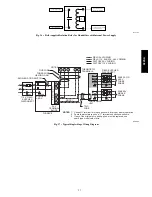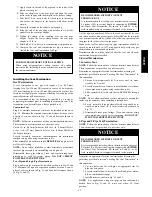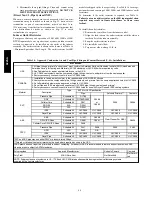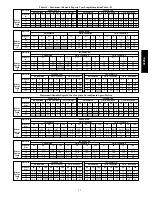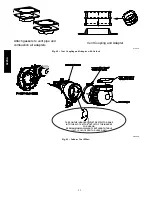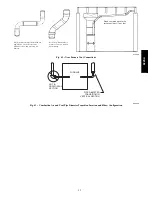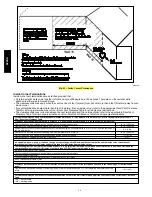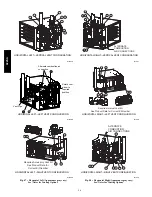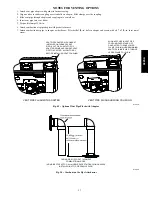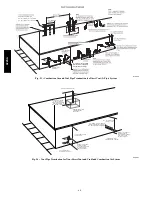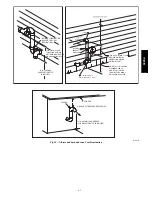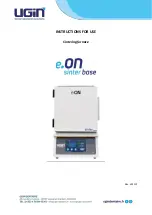
46
Table 13 – Hanger Spacing
Diameter
Material
PVC Sch 40
SDR 21 & 26
ABS
CPVC
Polypropylene
1 1/2--in.
3--ft.
2 1/2--ft.
3--ft.
3--ft.
3.25--ft.
38--mm
914--mm
762--mm
914--mm
914--mm
1000 mm
2--in.
3--ft.
3--ft.
3--ft.
3--ft.
3.25--ft.
51--mm
914--mm
914--mm
914--mm
914--mm
1000 mm
2 1/2--in.
3 1/2--ft.
3--ft.
3 1/2--ft.
3 1/2--ft.
3.25--ft.
64--mm
1067--mm
914--mm
1067--mm
1067--mm
1000 mm
3--in.
3 1/2--ft.
3--ft.
3 1/2--ft.
3 1/2--ft.
3.25--ft.
76--mm
1067--mm
914--mm
1067--mm
1067--mm
1000 mm
4--in.
4--ft.
3 1/2--ft.
4--ft.
4--ft.
3.25--ft.
The following instructions are for PVC/ABS DWV vent
piping only. DO NOT USE THESE TECHNIQUES FOR
POLYPROPYLENE VENT PIPING SYSTEMS. See the
polypropylene vent system manufacturer’s instructions for
installing polypropylene venting systems.
NOTICE
Install the remaining vent and combustion air pipes as shown
below. It is recommended that all pipes be cut, prepared, and
pre--assembled before permanently cementing any joint.
1. Working from furnace to outside, cut pipe to required
length(s).
2. De--burr inside and outside of pipe.
3. Chamfer outside edge of pipe for better distribution of
primer and cement.
4. Clean and dry all surfaces to be joined.
5. Check dry fit of pipe and mark insertion depth on pipe.
6. Insert the vent pipe into the vent elbow.
7. Torque clamp on vent elbow 15 lb--in.
8. Torque clamp on vent coupling 15 lb--in.
9. Insert the combustion air pipe into the adapter.
10. Pilot drill a screw hole through the adapter into the combus-
tion air pipe and secure the pipe to the adapter with sheet
metal screws.
DO NOT DRILL INTO POLYPROPY-
LENE VENT PIPES.
Use an optional accessory vent cou-
pling, if needed.
11. Seal around the combustion air pipe with silicone or foil
tape.
SILICONE SEALERS MAY NOT BE APPRO-
PRIATE FOR POLYPROPYLENE VENT SYSTEMS.
SEE POLYPROPYLENE VENT SYSTEM MANU-
FACTURER’S INSTRUCTIONS.
12. After pipes have been cut and pre--assembled, apply gener-
ous layer of cement primer to pipe fitting socket and end of
pipe to insertion mark. Quickly apply approved cement to
end of pipe and fitting socket (over primer). Apply cement
in a light, uniform coat on inside of socket to prevent
buildup of excess cement. Apply second coat.
DO NOT
CEMENT POLYPROPYLENE FITTINGS.
13. While cement is still wet, twist pipe into socket with 1/4--in.
turn. Be sure pipe is fully inserted into fitting socket.
14. Wipe excess cement from joint. A continuous bead of ce-
ment will be visible around perimeter of a properly made
joint.
15. Handle pipe joints carefully until cement sets.
16. Horizontal portions of the venting system shall be
supported to prevent sagging. Space combustion air piping
and vent piping hangars as shown in Table 13. Support
pipes using perforated metal hanging strap or commercially
available hangars or straps designed to support plastic pipe.
17. Slope the vent and combustion air piping downward
towards furnace. A minimum slope of at least 1/4-in. (6
mm) per linear ft.(1-in (25 mm) per 4 ft.(1.2 M)) with no
sags between hangers is required. See Caution Box below.
FURNACE RELIABILITY HAZARD
Failure to follow this caution may result in nuisance short
cycling, frozen vent termination, and/or no heat.
Slope the vent and combustion air piping downward towards
furnace a minimum of 1/4--in. (6 mm) per linear ft. of pipe.
CAUTION
!
18. Complete the vent and combustion air pipe installation by
connecting the concentric vent or by installing the required
termination elbows as shown in Figs. 53, 54 and 55.
For Ventilated Combustion Air Termination, See Fig. 56.
19. Use appropriate methods to seal openings where combus-
tion air pipe and vent pipe pass through roof or sidewall.
CARBON MONOXIDE POISONING HAZARD
Failure to follow this warning could result in personal injury
or death.
DO NOT
use cement to join polypropylene venting systems.
Follow the polypropylene venting system manufacturer’s
instructions for installing polypropylene venting systems.
!
WARNING
Optional Installation of the Vent Pipe
NOTE
:
DO NOT USE THIS TECHNIQUE FOR
POLYPROPYLENE VENTING SYSTEMS.
This option provides a disconnect point for the vent pipe. The vent
pipe must be cemented to the plastic vent pipe adapter to maintain
a sealed vestibule. See Fig. 49.
1. Insert a length of vent pipe through the casing into the
outlet of the vent elbow.
2. Slide the plastic vent pipe adapter over the length of the
vent pipe down to the furnace casing. Mark the pipe where
it is flush with the outlet of the adapter.
3. Remove the pipe from the furnace and the adapter and cut
off any excess pipe.
4. Clean and prime the end of the pipe that is flush with the
vent adapter with a primer that is appropriate for the type of
pipe being used.
5. Re--insert the pipe through the casing into the vent elbow.
6. Tighten the clamp around the outlet of the vent elbow.
Torque the clamp to 15 lb--in.
922SA






